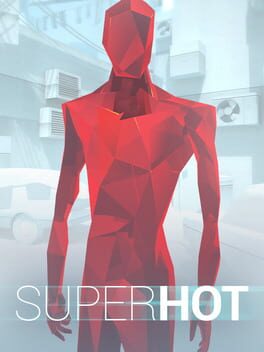Fascinating that by giving the player complete control over the pacing of chaotic shoot-outs, it turns what is fully mechanically an action game into something closer to a tactical spatial puzzle (the minimalist DOS demake of the game you can play in MCD basically fully confirmed this intuition for me that Superhot was, and always had been, a logic puzzle game first and foremost).
Undeniably effective as both a mechanical skeleton and visual showcase of the distinct art style of these games. The more I played of these games the more I felt their strongest asset was their clinically striking red against pure white pallets and tendency towards framing unexpectedly striking images (both intentional and incidental through player interaction). However, despite it's obvious strengths its hard to feel like this is anything other than a skeleton for something potentially greater. For a game entirely about making decisions about how you move, this is a shockingly limiting movement system for a first person shooter. There's not even a crouch button. But a game like this is just, begging for like a slide move or a dive or something. There were numerous occasions where I found myself in situations of assured death that would have been easily avoided were my little man capable of ducking under a goddamn bullet.
I'd be curious as to why the game made the call to limit player movement in such a way. Not having a crouch button feels too specific to have been an oversight, and I can imagine there's a good faith reason to have done so. But as it stands, parts of the game just feel, stiff and overly simple. The limited movement does force the player to think more critically about how and where to move, yes, but it also severely reduces the ability for the player to reactively solve problems in an intuitive way.
Buuuuut, despite my frustrations with the games simplicity, it has an undeniable knack for pacing it's encounters. There's a feeling of air-tightness for the unique layout of each encounter. Despite the simplicity of it all, the game does a good job of making sure every encounter feels unique and intentional. Each level space uses it's environmental layout and enemy placement to a specific end, to intentionally create unique situations the player has to think carefully about. But this also makes it all the more frustrating that literally just as the game starts introducing more complex and interesting systems to build off of, it just ends. When all is said and done, I feel like I've played an extremely impressive demo for what should be a longer and more fleshed out game to better explore this concept.
Also the narrative stuff would be a lot more interesting if they just, dropped the silly meta-text stuff? You had a cooler story without that, stop trying so hard to be clever on purpose, this is a game that lives and dies by its atmosphere.
Undeniably effective as both a mechanical skeleton and visual showcase of the distinct art style of these games. The more I played of these games the more I felt their strongest asset was their clinically striking red against pure white pallets and tendency towards framing unexpectedly striking images (both intentional and incidental through player interaction). However, despite it's obvious strengths its hard to feel like this is anything other than a skeleton for something potentially greater. For a game entirely about making decisions about how you move, this is a shockingly limiting movement system for a first person shooter. There's not even a crouch button. But a game like this is just, begging for like a slide move or a dive or something. There were numerous occasions where I found myself in situations of assured death that would have been easily avoided were my little man capable of ducking under a goddamn bullet.
I'd be curious as to why the game made the call to limit player movement in such a way. Not having a crouch button feels too specific to have been an oversight, and I can imagine there's a good faith reason to have done so. But as it stands, parts of the game just feel, stiff and overly simple. The limited movement does force the player to think more critically about how and where to move, yes, but it also severely reduces the ability for the player to reactively solve problems in an intuitive way.
Buuuuut, despite my frustrations with the games simplicity, it has an undeniable knack for pacing it's encounters. There's a feeling of air-tightness for the unique layout of each encounter. Despite the simplicity of it all, the game does a good job of making sure every encounter feels unique and intentional. Each level space uses it's environmental layout and enemy placement to a specific end, to intentionally create unique situations the player has to think carefully about. But this also makes it all the more frustrating that literally just as the game starts introducing more complex and interesting systems to build off of, it just ends. When all is said and done, I feel like I've played an extremely impressive demo for what should be a longer and more fleshed out game to better explore this concept.
Also the narrative stuff would be a lot more interesting if they just, dropped the silly meta-text stuff? You had a cooler story without that, stop trying so hard to be clever on purpose, this is a game that lives and dies by its atmosphere.
